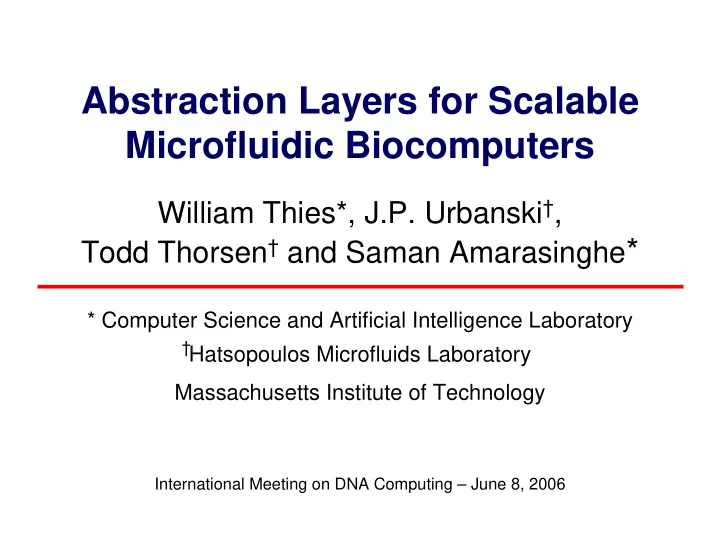

Abstraction Layers for Scalable Microfluidic Biocomputers William Thies*, J.P. Urbanski † , Todd Thorsen † and Saman Amarasinghe * * Computer Science and Artificial Intelligence Laboratory † Hatsopoulos Microfluids Laboratory Massachusetts Institute of Technology International Meeting on DNA Computing – June 8, 2006
Biocomputing Demands Complex Protocols • Complex biology experiments have many hazards – Time-consuming laboratory protocols – Risk of human error – Expensive reagents and equipment • Biocomputing: complexity grows with problem size [Adleman02] – 20-variable 3-SAT problem: >96 hours to complete – Larger instances will be even more challenging – Need a scalable approach • Our approach: Write protocols as programs, run on microfluidic chips – Write once, run anywhere – This talk: how do you “program” a biological protocol?
Microfluidic Chips • Idea: a whole biology lab on a single chip – Input/output – Sensors : luminescence, pH, glucose, etc. – Actuators : mixing, PCR, electrophoresis, cell lysis, etc. • Benefits: – Small sample volumes – High throughput – Geometrical manipulation 10x real-time 1 mm • Applications: – Biochemistry - Cell biology – Biological computing [Livstone/Landweber][van Noort] [Grover/Mathies] [McCaskill] [Gehani/Reif] [Farfel/Stefanovic] [Somei/Kaneda/Fujii/Murata]
Moore’s Law of Microfluidics: Valve Density Doubles Every 4 Months Source: Source: Fluidigm Corporation (http://www.fluidigm.com/images/mlaw_lg.jpg)
Moore’s Law of Microfluidics: Valve Density Doubles Every 4 Months Source: Source: Fluidigm Corporation (http://www.fluidigm.com/didIFC.htm)
How to Conduct Experiments? Lab-on-a-chip Human director Lab bench • Current choices: • Two choices: • Design custom microfluidic chip to • Design custom microfluidic chip to automatically perform your experiment automatically perform your experiment • Orchestrate every valve operation by hand (e.g., using Labview)
Programmable Solution • Example: Gradient generation Fluid yellow = input (0); Fluid blue = input (1); for (int i=0; i<=4; i++) { mix (yellow, 1-i/4, blue, i/4); } • Hidden from programmer: – Location of fluids – Details of mixing, I/O – Logic of valve control – Timing of chip operations 450 Valve Operations
Programmable Solution • Example: Gradient generation Fluid yellow = input (0); setValve(0, HIGH); setValve(1, HIGH); setValve(2, LOW); setValve(3, HIGH); Fluid blue = input (1); setValve(4, LOW); setValve(5, LOW); setValve(6, HIGH); setValve(7, LOW); for (int i=0; i<=4; i++) { setValve(8, LOW); setValve(9, HIGH); mix (yellow, 1-i/4, blue, i/4); setValve(10, LOW); setValve(11, HIGH); setValve(12, LOW); setValve(13, HIGH); } setValve(14, LOW); setValve(15, HIGH); setValve(16, LOW); setValve(17, LOW); setValve(18, LOW); setValve(19, LOW); • Hidden from programmer: wait(2000); setValve(14, HIGH); setValve(2, LOW); – Location of fluids wait(1000); setValve(4, HIGH); setValve(12, LOW); – Details of mixing, I/O setValve(16, HIGH); setValve(18, HIGH); setValve(19, LOW); – Logic of valve control wait(2000); – Timing of chip operations 450 Valve Operations
Recommend
More recommend